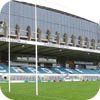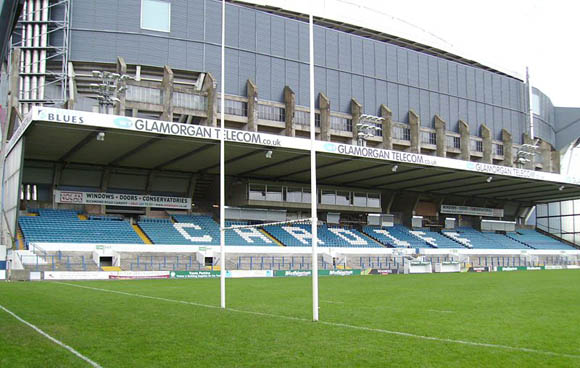
| Cardiff Arms Park
Cardiff Arms Park (also known simply as The Arms Park) is a rugby union stadium situated in the centre of Cardiff, Wales. It is home to the Cardiff Blues and Cardiff RFC. Cardiff Arms Park previously had two stadiums the Cardiff Rugby Ground and also the National Stadium.
The Millennium Stadium replaced the National Stadium in 1999. Although the Millennium Stadium is on roughly two thirds of the old National Stadium site, it is not considered to be part of Cardiff Arms Park and is not used in the address of the Millennium Stadium.
History
The Cardiff Arms Park site was originally called the Great Park a swampy meadow behind the Cardiff Arms Hotel and was owned by the Marquess of Bute. Cardiff Arms Park was named after the hotel/pub, which was demolished in 1878 . The Marquess of Bute stipulated that the ground could only be used for recreational purposes.
In 1881-2 saw the beginning of a stand for spectators, it held 300 people and cost GB�50. By 1922 Lord Bute had sold the land, and the site was bought by the Cardiff Arms Park Company Limited for �30,000, it was then leased to the Cardiff Athletic Club for 99 years at a cost of �200 per annum.
The first ever radio sports commentary from Wales came in the game between Wales and Ireland on 5 February 1927.
In 1934 the new North Stand was built, it cost about �20,000. But by 1941, the new North Stand and part of the west terrace had been hit in a blitz by the Luftwaffe.
At a general meeting of the Welsh Rugby Union (WRU) in June 1953, they made a decision,
� That until such time as the facilities at Swansea were improved, all international matches be played at Cardiff. �
The British Empire and Commonwealth games in 1958 had caused much damage to the drainage system, so much so that other rugby unions (England, Scotland and Ireland) complained about the state of the pitch. The Development Committee was set up to resolve this issue on a permanent basis. They looked at various sites in Cardiff, but they all proved to be unsatisfactory. They also could not agree a solution with the Cardiff Athletic Club, so they purchased about 80 acres of land at island farm in Bridgend. But problems arose, notable transport issues, and so Glamorgan County Council never gave outline planning permission for the proposals and by June 1964 the scheme was abandoned.
At this time Cardiff Arms Park consisted of the cricket ground to the north, used by Glamorgan County Cricket Club, and the rugby ground to the south, used by the national Wales team and also Cardiff RFC.
After agreement of the Cardiff Athletic Club the freehold of Cardiff Arms Park was transferred to the WRU in July 1968. Work could then begin on the National Stadium. Cardiff RFC then moved onto the old cricket ground, allowing the National Stadium to be built.
The National Stadium
The National Stadium (also known as the Welsh National Rugby Ground, located at 51�28′43″N, 3�10′57.5″W) was designed by Osborne V Webb and Partners and was built by G A Williamson & Associates of Porthcawl and Andrew Scott & Company of Port Talbot. On 17 October 1970 the new North Stand and the Cardiff RFC ground was completed, the North Stand cost just over �1 million.
The West Stand was opened in 1977 and the new East Terrace was completed by March 1980. By the time the South Stand had been completed by 7 April 1984, the stand had cost �4.5M.
At the start of the project, the total cost was estimated at �2.25M, although by time it was finished in 1984, it had risen by nearly four times that amount
The two stadiums on the site both had approximately east-west alignment; the Cardiff Rugby Ground to the north (Castle Street) end, and the National Stadium to the south (Wood Street) end. The original capacity was 65,000 but this had to be reduced in later years to 53,000 for safety reasons. 11,000 of these were on the East Terraces and the conversion to all seater stadium would have reduced the stadium capacity still further to 47,500. This capacity would have been much less than Twickenham and the other major rugby venues and also less than the demand for tickets to major events.
Cardiff Arms Park and the Millennium Stadium
Just thirteen years later in 1997, the National Stadium was considered too small and did not have the facilities required of the time and it was demolished and a new stadium, the Millennium Stadium, was built in its place (completed to a north-south alignment in 1999).
Now only the rugby club ground still uses the name Cardiff Arms Park for its ground. It is also still physically attached to the Millennium Stadium at the North Stand, known colloquially as Glanmor's Gap (right), after Glanmor Griffiths, former chair, now President of the WRU. Cardiff Arms Park is known throughout the world as the home of Welsh rugby, but the site has also been home to many other sports.
Sports and other events held at Cardiff Arms Park
Athletics (track and field)
In 1958, the British Empire and Commonwealth Games were held in Cardiff, and the track and field events took place on what was the greyhound track.
Boxing
Around 25000 spectators watched international boxing on 1 October 1993 at the National Stadium with a World Boxing Council (WBC) Heavyweight title bout between Lennox Lewis and Frank Bruno. On 30 September 1995, Steve Robinson the World Boxing Organization (WBO) World Featherweight Champion, lost against Prince Naseem Hamed at the Cardiff Rugby Ground in 8 rounds.
Cricket
In 1845 Cardiff Cricket Club was formed and in 1848 made it its new home. Glamorgan Cricket Club, at the time not a first-class county, played their first match at Cardiff Arms Park in mid-June 1869, against Monmouthshire. They played their first-ever County Championship match there in 1921, competing there every season (except while first-class cricket was suspended during the Second World War), their last match being against Somerset in August 1966. Glamorgan then moved to a new ground Sophia Gardens on the opposite bank of the River Taff to the Arms Park, following work on the creation of a national rugby stadium, later to be called the National Stadium.
The first first-class cricket match actually to be held on the ground was between West of England and East of England, on 20 June 1910. More than 240 first-class cricket matches were played at Cardiff Arms Park.
Only one List A game was ever played at the ground, and this was only the second match of its type: Glamorgan's Gillette Cup fixture against Somerset on 22 May 1963. Except for the aforementioned 1910 game, the only major match not to involve Glamorgan was a Test Trial in July 1932, which was badly affected by the weather and saw play on only one of the scheduled three days.
Football (soccer)
The Riverside Football Club, founded in 1899, played some matches at the Arms Park until 1910, when they moved to Ninian Park and later became Cardiff City Football Club.
On 31 May 1989 Wales played its first international game against West Germany at the National Stadium. It was also the first ever international football match held in Britain that was watched by all-seater spectators. The Football Association of Wales also paid for flood-lights to be installed into the stadium so that evening matches could be held at the stadium.
Greyhound racing
To help pay for the upkeep of the site a greyhound track opened in 1927. The greyhound company signed a 50-year lease in 1937, with the owners of Cardiff Arms Park having no rights to break the agreement or to review the rental until the 50 years were up. However the last greyhound race was actually held on 30 July 1977.
Rugby Union
In 1876 the Cardiff Rugby Football Club was formed and soon after they also used the park. On 12 April 1884 the first international match was played at the ground between Wales and Ireland, when 5,000 people watched Wales beat Ireland.
The stadium became the permanent home of the Welsh national team in 1964. The National Stadium was also home to the WRU Challenge Cup from 1972 until the last ever match that was held on 26th April 1997 at reduced capacity National Stadium between Cardiff and Swansea. Cardiff won the match by 33-26, with a try by Nigel Walker.
The stadium hosted 4 games in the 1991 Rugby World Cup, including the 3rd / 4th place play-off.
The inaugural Heineken Cup final of 1995-6 and the following final in 1996-7 were held at the National Stadium. The Heineken Cup is Europe's premier Rugby Union club competition.
Music concerts and other events
Major music concerts were also held at the National Stadium: - David Bowie The Glass Spider World Tour 21 June 1987
- U2 Joshua Tree Tour 25 July 1987
- Michael Jackson Bad World Tour 26 July 1988
- The Rolling Stones Urban Jungle Tour 16 July 1990
- Dire Straits European Tour 11 June 1992
- Michael Jackson Dangerous World Tour 5 August 1992
- U2 Zoo TV Tour 18 August 1993
- Jose Carreras 30 July 1994
- Tina Turner Wildest Dreams Tour 14 July 1996
- Jehovah's Witnesses held their annual conventions at the National Stadium and continue to do so at the Millennium Stadium
Future
With the announcement on 19 September 2007 that the Cardiff Blues are to move from Cardiff Arms Park for the season 2009-2010 to a new stadium at Leckwith. There is doubt about the future of Cardiff Arms Park after 2010. Cardiff RFC have a 15 year lease on the stadium. The land is owned by Cardiff Athletics Club, but it still has the original requirement that the land will only be used for recreational purposes, as stipulated by Lord Bute. But the Cardiff Arms Park site is a prime piece of real estate in the centre of Cardiff, which means that it may be difficult to sell to property developers. The council have been looking for a site for a conference centre. A decision by Cardiff Athletics Club on the future of Cardiff Arms Park could be made by 2008. |









